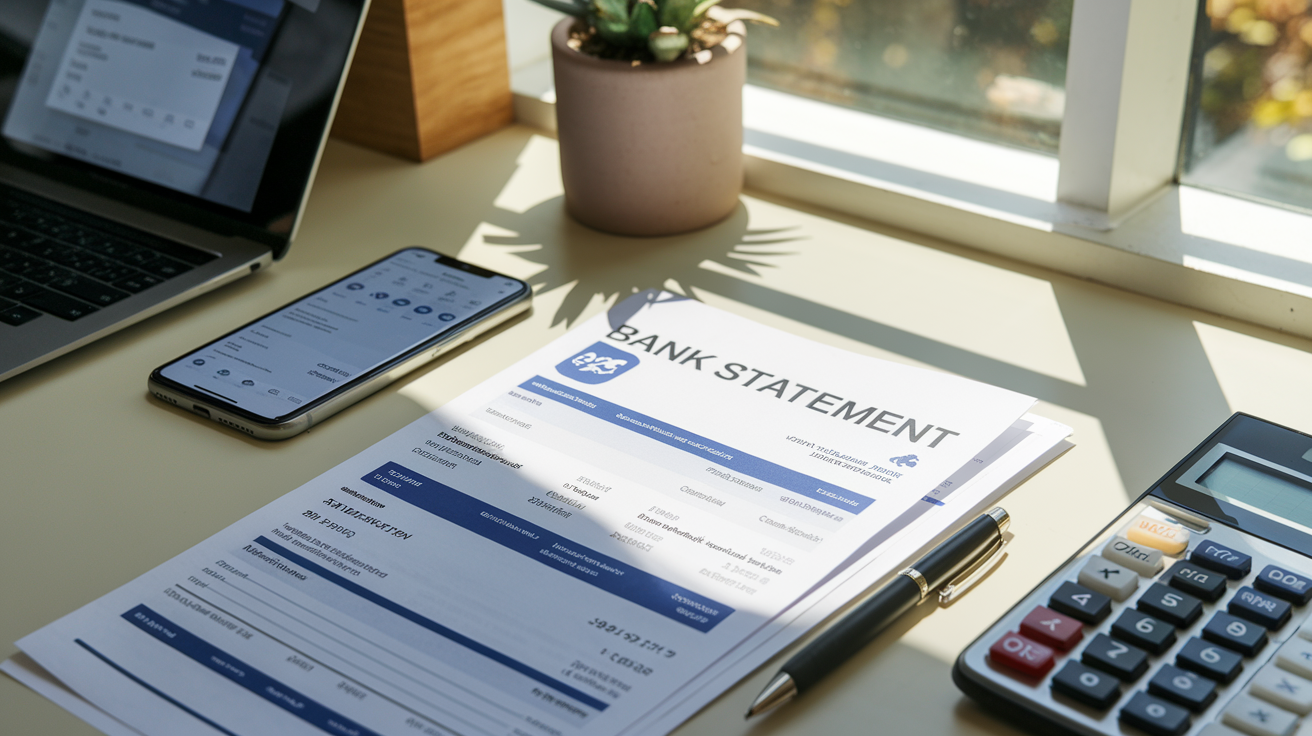A Business Bank Statement Generator is a resource that produces fake or replacement bank statements for businesses. These generators can create a bank statement in the form of a document containing the same kind of information that appears on any actual bank statement. It provides easy customization, nice look & feel, realistic layout and support for automatic generation of positioning tables.
Understanding Business Bank Statement Generator

Key components of a bank statement
A business bank statement generator typically contains several crucial elements:
-
Account Information
-
Transaction Details
-
Beginning and Ending Balances
-
Fees and Charges
-
Interest Earned
Here’s a breakdown of these components:
| Component | Description |
|---|---|
| Account Information | Account number, business name, statement period |
| Transaction Details | Date, description, deposits, withdrawals, and running balance |
| Beginning/Ending Balances | Opening and closing balances for the statement period |
| Fees and Charges | Any bank fees or service charges applied to the account |
| Interest Earned | Interest accrued on the account balance (if applicable) |
Importance for financial management
Business bank statements play a vital role in financial management:
-
Reconciliation: Helps verify recorded transactions against actual bank activity
-
Cash flow tracking: Provides insights into income and expenditure patterns
-
Budgeting: Assists in creating accurate financial projections
-
Fraud detection: Allows for timely identification of unauthorized transactions
Legal and tax implications
Accurate bank statements are crucial for several legal and tax reasons:
-
Audit trail: Provides evidence of financial transactions
-
Tax reporting: Essential for preparing tax returns and supporting deductions
-
Compliance: Helps meet regulatory requirements for financial record-keeping
-
Legal disputes: Can serve as evidence in case of financial disagreements
By understanding these key aspects of business bank statements, you can better manage your finances and ensure compliance with legal and tax obligations.
Choosing the Right Tools for Statement Creation

Online banking platforms
Online banking platforms offer a convenient way to create business bank statements quickly. Many banks provide built-in features for generating statements, making it easy for business owners to access their financial records anytime, anywhere.
-
Real-time updates
-
Easy access to historical data
-
Customizable date ranges
-
Downloadable formats (PDF, CSV)
Accounting software options
Accounting software integrates seamlessly with your business operations, providing a comprehensive solution for financial management, including bank statement creation.
| Software | Key Features |
|---|---|
| QuickBooks | Bank sync, automated categorization |
| Xero | Multi-currency support, custom reports |
| FreshBooks | Time tracking, expense management |
Specialized statement generation tools
For businesses requiring more tailored solutions, specialized statement generation tools offer advanced features and customization options.
-
Enhanced security measures
-
Advanced formatting capabilities
-
Integration with multiple financial institutions
-
Automated data reconciliation
Pros and cons of each method
When selecting the right tool for creating business bank statements, consider the following:
-
Online banking platforms:
-
Pros: Easy access, real-time data
-
Cons: Limited customization, bank-specific features
-
-
Accounting software:
-
Pros: Comprehensive financial management, integration with other business processes
-
Cons: Learning curve, potentially higher costs
-
-
Specialized tools:
-
Pros: Advanced features, high customization
-
Cons: May require technical expertise, additional investment
-
Now that we’ve explored the various tools available for creating business bank statements, let’s dive into streamlining the data collection process to further expedite statement generation.
Streamlining the Data Collection Process

Organizing financial transactions
Efficient organization of financial transactions is crucial for streamlining the data collection process. Start by categorizing your transactions into clear, distinct groups such as income, expenses, and transfers. This approach allows for easier tracking and analysis of your business’s financial health.
-
Income categories: Sales revenue, investment income, interest
-
Expense categories: Rent, utilities, payroll, supplies
-
Transfer categories: Inter-account movements, loan payments
Implement a consistent naming convention for your transactions to enhance searchability and reduce confusion. For instance, use prefixes like “INV-” for invoices or “EXP-” for expenses.
Automating data entry
Automating data entry significantly reduces the time and effort required to create business bank statements. Leverage optical character recognition (OCR) technology to scan and digitize physical receipts and invoices. This eliminates manual data entry and minimizes errors.
| Automation Method | Benefits | Considerations |
|---|---|---|
| OCR Technology | Rapid digitization, reduced errors | Initial setup cost |
| Bank Feed Integration | Real-time transaction updates | Security measures needed |
| AI-powered categorization | Automatic transaction sorting | Occasional manual review required |
Integrating with existing systems
Seamless integration with your current financial systems is key to efficient data collection. Connect your statement creation tool with your accounting software, point-of-sale systems, and e-commerce platforms. This integration ensures that all financial data flows automatically into your statement generation process.
-
Choose compatible software that offers API connections
-
Set up regular data synchronization to maintain up-to-date records
-
Establish data validation rules to catch discrepancies early
By implementing these strategies, you’ll create a robust data collection process that forms the foundation for quick and accurate business bank statement generation. With organized transactions, automated entry, and integrated systems, you’ll be well-prepared to move on to the actual statement creation process.
Step-by-Step Guide to Quick Statement Generation

Setting up your account information
To begin creating your business bank statement quickly, start by setting up your account information. This crucial step ensures that your statement accurately reflects your business details.
-
Gather essential information:
-
Business name and address
-
Account number
-
Bank name and branch details
-
Statement period dates
-
-
Enter the data into your chosen statement generation tool:
-
Look for a dedicated “Account Setup” or “Business Profile” section
-
Double-check all entered information for accuracy
-
Inputting transaction data
Next, focus on inputting your transaction data. This process can be streamlined using various methods:
-
Manual entry:
-
Input each transaction individually
-
Ideal for businesses with few monthly transactions
-
-
Bulk import:
-
Use CSV or Excel files to import multiple transactions at once
-
Perfect for businesses with numerous transactions
-
-
Bank integration:
-
Connect your bank account directly to the statement generation tool
-
Automatically imports transactions, saving significant time
-
| Method | Pros | Cons |
|---|---|---|
| Manual entry | High accuracy, full control | Time-consuming |
| Bulk import | Efficient for large datasets | Potential for import errors |
| Bank integration | Fastest, most automated | May require additional setup |
Customizing statement layout
Tailor your statement’s appearance to match your brand and preferences:
-
Choose a template:
-
Select from pre-designed layouts or create a custom design
-
Ensure the template includes all necessary information fields
-
-
Add your business logo:
-
Upload a high-quality image of your logo
-
Position it prominently on the statement
-
-
Adjust fonts and colors:
-
Select fonts that are easy to read
-
Use colors that align with your brand identity
-
Reviewing and finalizing the document
Before generating your final statement, conduct a thorough review:
-
Check for accuracy:
-
Verify all transactions and balances
-
Ensure dates and account details are correct
-
-
Preview the statement:
-
Review the layout and formatting
-
Make any necessary adjustments
-
-
Generate the final document:
-
Choose your preferred file format (PDF, CSV, etc.)
-
Save or download the completed statement
-
By following these steps, you can quickly create accurate and professional business bank statements. This efficient process allows you to focus on other important aspects of your financial management.
Ensuring Accuracy and Compliance

Double-checking figures and calculations
Ensuring the accuracy of your business bank statements is crucial for maintaining financial integrity and compliance. Here’s a systematic approach to double-check your figures and calculations:
-
Reconciliation process:
-
Compare bank statement entries with your internal records
-
Verify opening and closing balances
-
Cross-reference transactions with receipts and invoices
-
-
Use of automated tools:
-
Employ accounting software for automatic calculations
-
Utilize built-in error detection features
-
-
Manual review checklist:
-
Check for transposition errors
-
Verify decimal point placement
-
Ensure correct categorization of income and expenses
-
| Verification Step | Method | Frequency |
|---|---|---|
| Balance check | Compare statement vs. ledger | Monthly |
| Transaction audit | Sample testing | Quarterly |
| Full reconciliation | Detailed review | Annually |
Adhering to financial reporting standards
Compliance with financial reporting standards is essential for legal and ethical business practices. Key considerations include:
-
Familiarize yourself with GAAP or IFRS requirements
-
Ensure consistent application of accounting principles
-
Maintain proper documentation for all financial transactions
Implementing internal controls
Robust internal controls safeguard against errors and fraud:
-
Segregation of duties
-
Regular audits and reviews
-
Secure access to financial systems
-
Clear approval processes for transactions
By implementing these measures, you’ll significantly enhance the accuracy and reliability of your business bank statements. This attention to detail not only ensures compliance but also provides a solid foundation for informed decision-making and financial planning.
Leveraging Technology for Time-Saving Features

Templates and pre-set formats
Modern bank statement creation tools offer a wide array of templates and pre-set formats, saving businesses valuable time and effort. These templates cater to various industries and reporting styles, ensuring that your statements look professional and consistent.
| Template Type | Benefits |
|---|---|
| Industry-specific | Tailored to sector requirements |
| Customizable | Adaptable to unique business needs |
| Compliance-focused | Meets regulatory standards |
| Multi-currency | Supports international transactions |
Automatic calculations and summaries
One of the most time-saving features of advanced bank statement software is automatic calculations and summaries. These tools can:
-
Calculate account balances instantly
-
Generate transaction summaries by category
-
Provide visual representations of cash flow
-
Highlight discrepancies or unusual activity
Cloud-based accessibility
Cloud-based solutions offer unparalleled convenience for creating and accessing business bank statements. Benefits include:
-
24/7 access from anywhere with an internet connection
-
Real-time updates and synchronization
-
Enhanced security measures to protect sensitive financial data
-
Scalability to accommodate growing businesses
Multi-device synchronization
The ability to synchronize across multiple devices further enhances productivity. This feature allows team members to:
-
Collaborate on statement creation from different locations
-
Access up-to-date financial information on smartphones or tablets
-
Seamlessly switch between devices without losing progress
By leveraging these technological advancements, businesses can significantly reduce the time spent on creating bank statements, allowing more focus on strategic financial management and growth initiatives.
Maximizing the Benefits of Rapid Statement Creation

Improved cash flow management
Rapid statement creation revolutionizes cash flow management for businesses. With instant access to up-to-date financial data, you can:
-
Monitor daily cash positions
-
Identify spending patterns
-
Forecast future cash needs
-
Detect and address cash flow issues proactively
By leveraging quick statement generation, businesses can make informed decisions about expenditures, investments, and revenue strategies in real-time.
Faster decision-making processes
Timely financial information is crucial for agile business operations. Rapid statement creation enables:
| Benefit | Impact |
|---|---|
| Real-time insights | Immediate response to market changes |
| Data-driven choices | Reduced guesswork in financial planning |
| Efficient resource allocation | Optimal use of available funds |
| Quick problem identification | Faster resolution of financial issues |
Enhanced investor and stakeholder communication
Frequent and accurate financial reporting builds trust and transparency with investors and stakeholders. Rapid statement creation allows for:
-
Regular updates on financial performance
-
Timely responses to investor inquiries
-
Clear demonstration of fiscal responsibility
-
Improved credibility in the business community
Streamlined loan application procedures
Quick access to comprehensive financial statements significantly expedites loan applications. Benefits include:
-
Reduced time in gathering required documentation
-
Increased accuracy in financial representations
-
Improved chances of loan approval
-
Faster processing of loan requests
By having up-to-date statements readily available, businesses can seize time-sensitive opportunities that require immediate financing.
Now that we’ve explored the advantages of rapid statement creation, let’s delve into how technology can further enhance these benefits through advanced features and automation.

Creating business bank statements quickly and accurately is crucial for maintaining financial transparency and making informed decisions. By leveraging the right tools and streamlining your data collection process, you can generate comprehensive statements in a matter of minutes. This not only saves valuable time but also ensures compliance with regulatory requirements.
As you implement these time-saving techniques, remember that accuracy remains paramount. Utilize technology-driven features to double-check your statements and maximize the benefits of rapid creation. By mastering this process, you’ll be better equipped to manage your business finances, impress stakeholders, and stay ahead in today’s fast-paced business environment. Take action now to revolutionize your financial reporting and unlock new opportunities for growth and success.
Q&A
Q1: What is a commercial bank statement?
A1: A business bank statement generator create report of the transactional history of a business for a given period, includes, deposits, withdrawals, and balances.
Q2: Why should I generate professional business bank statements?
A2 : Business bank statements are a must-have for the purpose of financial reporting, loan applications, tax compliance, and keep good financial credibility.
Q3: What are ways through which I can generate business bank statements fast and effectively?
A3: Use online business bank statement generation software or templates to generate a professional looking statement within just a few minutes.
Q4: What are the details that I need to come up with a business bank statement?
A4: You should gather your business’s financial information, transaction histories, account information and any other pertinent financial information.
Q5: Can I have my business bank statements personalized?
A5: Sure, there are a plethora of online tools and software from where you can get personalized bank statements for your business and company logo, branding and all the financial info.
Q6: Are online business bank statement makers safe?
A6: Reputable online generators have in place encrypted security to protect your financial data.
Q7: Are business bank statements acceptable for loan applications?
A7. Yes, you can use commercial business bank statements to build a loan application by showing some stability and legitimacy in your business.
With these Q&A, you can answer a number of questions in the minds of many companies which wish to make professional bank statement.
Revolutionize Your Business Finances: The Ultimate Guide to Business Bank Statement Generators”
Are you tired of manually generating bank statements for your business? Do you struggle with accuracy and efficiency in your financial management? A business bank statement generator can be the solution to your problems.
The Benefits of Using a Business Bank Statement Generator
– Save time and effort with automated statement generation
– Reduce errors and inaccuracies with advanced calculations
– Customize your statements to fit your business needs and brand
Types of Business Bank Statement Generators
– Free business bank statement generator: A cost-effective solution for small businesses or individuals
– Business bank statement generator online: Accessible from anywhere, providing convenience and flexibility
– Business bank statement generator pdf: Produce statements in PDF format for easy sharing and storage
– Business bank statement generator with account number: Ensure accuracy and security with statements that include your account number
– AI bank statement generator: Utilize artificial intelligence to automate the statement generation process
ORDER NOW
Additional Features to Consider
– 3 month bank statement generator: Generate statements for a specific period, such as 3 months
– Free bank statement generator: Find free generators that offer basic features and functionality
– Business bank statement generator app: Downloadable apps that provide on-the-go access to statement generation
Why Choose a Business Bank Statement Generator?
– Increase efficiency and productivity in your financial management
– Improve accuracy and reduce errors in your statements
– Enhance your business’s professional image with accurate and customized statements
By using a business bank statement generator, you can streamline your financial management and focus on growing your business. Try a business bank statement generator online or app today and experience the benefits of automated statement generation.
Contact now to order




